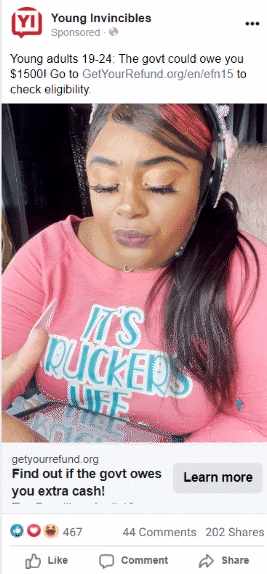Getting Young, Lower-Income Workers Paid
EITC Funders Network
A pilot campaign to engage “hard to reach” audiences through authentic social media influencers
Three of the pilot campaign’s amazing TikTok influencers: @nessadiosada, @b.little, and @thej.one.8.
The Challenge
Poverty rates for young adults are among the highest of any age group living in the U.S. While the Earned Income Tax Credit (EITC) has helped millions of low- and moderate-income people lift themselves out of or avoid poverty, the program excludes 19 to 24-year-olds. As a result, instead of getting a refund every April, these young workers get left further behind. The COVID-19 pandemic underscored the inequity of the EITC exclusion, with an over-representation of low-income 19-to-24-year-olds from communities of color in the ranks of our country’s “essential” workers. In response, Congress temporarily expanded the EITC to include 19-to-24-year-olds who made up to $21,000 in 2021, even if they’ve never filed before. While not the permanent fix needed, the temporary expansion meant up to $1,500 in the pockets of millions of hardworking young adults. But to get the money they deserve, these young workers had to file their taxes.
Enter the EITC Funders Network, who in early 2022 asked—with the April 18 tax deadline looming—how can we quickly reach young, lower-income workers about an issue they don’t typically follow, and with an action very few of us like to take (“do your taxes!”)?
our Solution
With only a handful of weeks left until the tax deadline and no existing campaign infrastructure, we knew the traditional playbook for awareness and advocacy campaigns wouldn’t cut it. So 1235 Strategies assembled an integrated campaign team that included the best in consumer marketing (Honor Code Creative) and digital cause marketing (Daigneault Digital) to workshop an innovative solution.
First, we recommended the pilot campaign stay laser-focused on one ambitious goal: Drive young, lower-income Black and brown workers to GetYourRefund.org (GYR.org), a 100 percent free tax service by Code for America where these young adults could start filing their taxes.
Second, we recommended the Network do what many funders and nonprofits have yet to try: Put the pilot campaign’s creative development entirely in the hands of a strategic group of authentic social influencers.
The pilot campaign’s top-performing influencer was @dukelovestaxes. Duke’s video used both humor and credible tax advice to motivate our targeted demographic.
Our hypothesis was the following: If we center social influencers who speak or connect to the experiences of lower-income young adults and bring their own built-in channels to reach this demographic, we can start to fill the Network’s gap in audience reach. And if we trust these influencers to serve as content creators, the pilot campaign’s messages and content will be more effective and efficient, which was crucial given that we didn’t have the time or resources to integrate campaign messaging with GYR.org.
The podcaster and TikTok influencer @ieinfriends used funny and personal messaging to drive traffic to GYR.org.
Third, and finally, we recommended the pilot campaign launch digital paid ads to test different creative content from our influencer partners as well as targeting strategies to amplify the power of these influencers beyond their dedicated followings.
The pilot’s top-performing ad creative for the duration of the ad campaign featured @clarissarankin, whose charming and funny video also had a strong performance on TikTok.
the Impact
Our hypothesis proved correct: In just five weeks, our pilot campaign for the EITC Funders Network generated over 141,000 homepage views to GYR.org. And as a bonus, these views turned into more than $626,000 in estimated tax refunds for 19-to-24-year-old workers.
To achieve these topline results, we created partnerships with nine social influencers (including seven on TikTok and two on Instagram) with predominant followings of young adults from Black and brown communities. Collectively, these influencers secured over 307,000 engagements and reached 2.7 million individuals. We also launched an ad campaign on Facebook with six sets of ad creative, which reached 1.3 million individuals, more than 80 percent of whom were within our targeted age demographic.
The pilot’s ad campaign also featured a great TikTok explainer video from @joshuaerabu.
Lessons Learned
Ultimately, what worked is that the pilot campaign started and remained audience-centric, which gave the pilot space to develop and shoulder innovations that went beyond capacity-building. Here are the highlights:
We suggested some short and sweet messages (“it’s your money, you deserve it, go get paid”) and then let our social influencer partners run with it, understanding they know their audiences best and the more authentic their content, the better.
We partnered with targeted but various kinds of social influencers, including some with mass reach and others with focused engagement.
We experimented with different channels (TikTok and Instagram) and then, based on initial results, focused our resources on where we were getting traction (TikTok).
We used the influencer content to run in ads, making production quick and effective, and then, based on initial results, focused on ad creative that was getting traction.
We partnered with one offline partner—Young Invincibles—to serve as the host of our paid ads because its mission of organizing young adults to help shape policy debates could absorb and leverage the brand attention.
We kept other offline partners (i.e., funders, policy nonprofits, etc.) in the loop, sharing content and suggesting messaging, but we kept campaign resources squarely centered on reaching young, lower-income, Black and brown workers before the tax deadline.







